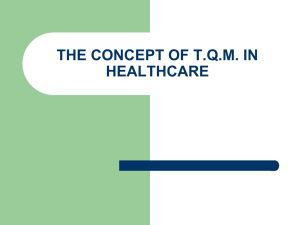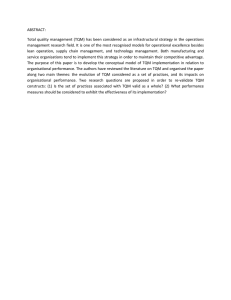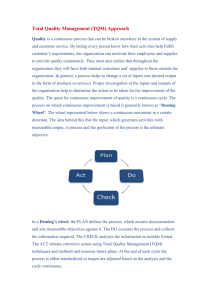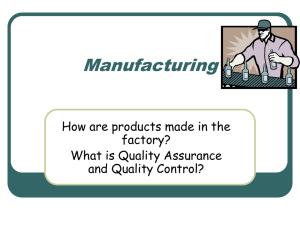Demonstrate understanding of advanced concepts used
advertisement
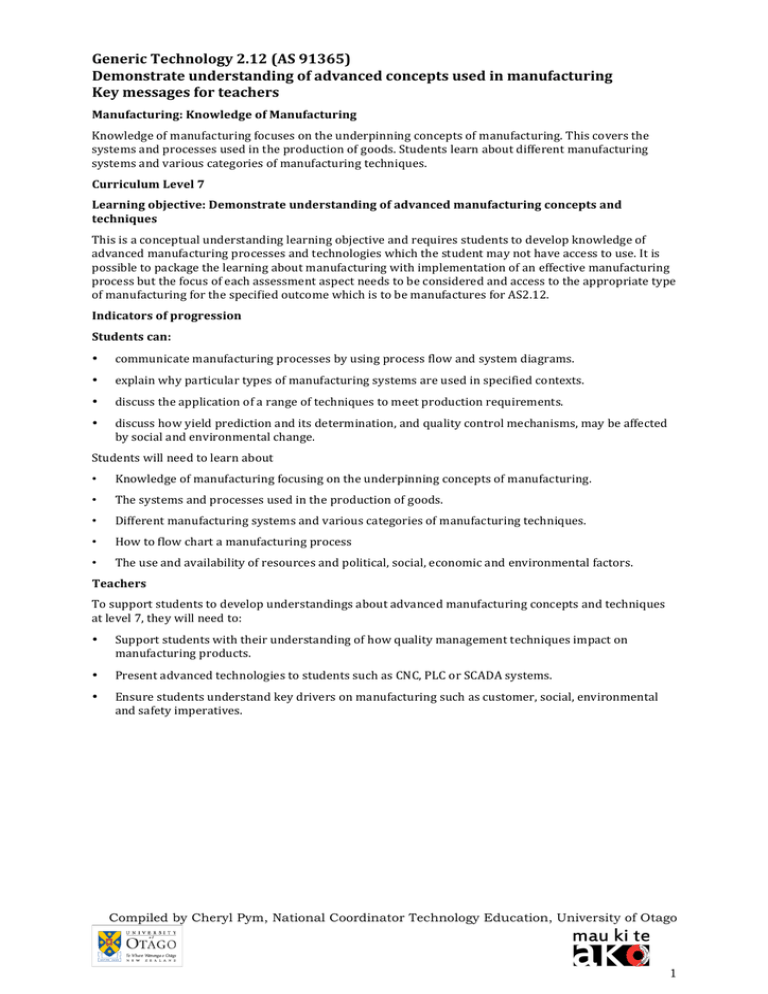
Generic Technology 2.12 (AS 91365) Demonstrate understanding of advanced concepts used in manufacturing Key messages for teachers Manufacturing: Knowledge of Manufacturing Knowledge of manufacturing focuses on the underpinning concepts of manufacturing. This covers the systems and processes used in the production of goods. Students learn about different manufacturing systems and various categories of manufacturing techniques. Curriculum Level 7 Learning objective: Demonstrate understanding of advanced manufacturing concepts and techniques This is a conceptual understanding learning objective and requires students to develop knowledge of advanced manufacturing processes and technologies which the student may not have access to use. It is possible to package the learning about manufacturing with implementation of an effective manufacturing process but the focus of each assessment aspect needs to be considered and access to the appropriate type of manufacturing for the specified outcome which is to be manufactures for AS2.12. Indicators of progression Students can: • communicate manufacturing processes by using process flow and system diagrams. • explain why particular types of manufacturing systems are used in specified contexts. • discuss the application of a range of techniques to meet production requirements. • discuss how yield prediction and its determination, and quality control mechanisms, may be affected by social and environmental change. Students will need to learn about • Knowledge of manufacturing focusing on the underpinning concepts of manufacturing. • The systems and processes used in the production of goods. • Different manufacturing systems and various categories of manufacturing techniques. • How to flow chart a manufacturing process • The use and availability of resources and political, social, economic and environmental factors. Teachers To support students to develop understandings about advanced manufacturing concepts and techniques at level 7, they will need to: • Support students with their understanding of how quality management techniques impact on manufacturing products. • Present advanced technologies to students such as CNC, PLC or SCADA systems. • Ensure students understand key drivers on manufacturing such as customer, social, environmental and safety imperatives. Compiled by Cheryl Pym, National Coordinator Technology Education, University of Otago 1 Key messages about the standard, resources and assessment specifications. Literacy considerations Students will be required to identify, explain and discuss in the context of manufacturing. Students will need to be able to confidently communicate the following: • explain how safety issues were addressed in a manufacturing process • identify the impacts of new technologies and/or techniques on the suitability of different types of manufacturing systems and increased possibilities for quality control • identify the influences of customer, social and environmental drivers on priorities within a manufacturing process • explain how quality management techniques have impacted on a manufacturing process • discuss how and why quality management techniques have been important in changing manufacturing practices. They will also need to develop the skills such as: • communicate ideas-­‐ graphically and in an annotated format • undertake research and use this to inform their work-­‐ sift sort and synthesise information • use correct conventions in flow charting a manufacturing process • ability to understand TQM and quality control processes ( this will support students in the implementation of manufacturing process AS2.13) Key definitions Safety issues in manufacturing include those associated with the outcome, the workers involved in its production, and environmental impacts. New technologies and/or techniques may include but are not limited to: computer numerical controlled (CNC) machine tools, electronics assemblies, programmable logic control (PLC), Supervisory Control and Data Acquisition (SCADA) control systems, force field analysis. Types of manufacturing systems include, but are not limited to: • one-­‐off custom manufacturing of a unique single product • batch, intermittent or short-­‐run manufacturing – multiple copies of the same product or a single batch of a processed product • continuous (often called “assembly line”) manufacture • flexible manufacture and customisation. Quality management techniques may include, but are not limited to, Total Quality Management (TQM) and Six Sigma. Compiled by Cheryl Pym, National Coordinator Technology Education, University of Otago 2 Step up AS 1.12 to 2.1 For AS1.12 Students demonstrate their understanding of manufacturing by: • Discussing different manufacturing systems and various categories of manufacturing techniques. • Explaining how safety issues were addressed in a manufacturing process. • Identifying the impacts of new technologies and/or techniques on the suitability of different types of manufacturing systems and increased possibilities for quality control. • Discussing how and why quality management techniques have been important in changing manufacturing practices. For AS2.12 (Note: Students will need to draw on previous knowledge) Students are required to demonstrate their understanding of manufacturing by: • Communicating manufacturing processes by using process flow and system diagrams. • Explaining why particular types of manufacturing systems are used in specified contexts. • Discussing the application of a range of techniques to meet production requirements. • Discussing how yield prediction and its determination, and quality control mechanisms, may be affected by social and environmental change. Key teaching points to consider: • Select a context where students will have access to information on safety issues, new technologies and/or techniques, and quality management techniques. This information could be collected through industry visits, visiting speakers, and from online sources. • Safety issues in manufacturing include those associated with the outcome, the workers involved in its production, and environmental impacts. • New technologies and/or techniques may include but are not limited to: computer numerical controlled (CNC) machine tools, electronics assemblies, programmable logic control (PLC), Supervisory Control and Data Acquisition (SCADA) control systems, force field analysis. • Types of manufacturing systems include but are not limited to: • one-­‐off custom manufacturing of a unique single product • batch, intermittent or short-­‐run manufacturing -­‐ multiple copies of the same product or a single batch of a processed product • continuous ( ‘assembly line’) manufacture • flexible manufacture and customisation. • Quality management techniques may include but are not limited to Total Quality Management (TQM) and Six Sigma. • Manufacturing processes may include but are not limited to: milk powder manufacture, beer brewing, meat packing and freezing, carpet manufacture, urea from natural gas, newsprint, oil refining, injection moulded plastics, electronics, fish filleting and freezing, rotationally moulded plastics, superphosphate, agricultural machinery, possum and merino yarn, marine/leisure products, niche furniture and garment manufacture. Choosing the context for the learning and assessment • The teacher may specify the context for the activity in discussion with the class and/or you may allow individual students to negotiate an alternative context. • The students may present their report in any appropriate format and medium that they have agreed with you in advance. For example, they could present it as a slideshow, a display board, a written report, or a portfolio. Creating the report is an individual activity, but students may investigate the selected manufacturing process either independently, with a partner, or in a group Compiled by Cheryl Pym, National Coordinator Technology Education, University of Otago 3 Resources to support student achievement: Achievement standard 2.12 Assessment resources on TKI • ncea.tki.org.nz/Resources-­‐for-­‐aligned-­‐standards/Technology/Level-­‐2-­‐Technology Technology Conditions of Assessment • ncea.tki.org.nz/content/download/4296/13980/file/tech_CoA_L2_nov11.doc Exemplars on NZQA-­‐ Currently in development • www.nzqa.govt.nz/qualifications-­‐standards/qualifications/ncea/subjects/technology/technology-­‐ annotated-­‐exemplars/ Curriculum Support Material on Techlink • Indicators of Progression – Indicators of Progression for the Learning Objectives for the Technology specialist Knowledge and Skills strands: www.techlink.org.nz/curriculum-­‐support/indicators/Learning-­‐Objectives/index.htm Techlink case studies relating to manufacturing The following case studies on Techlink introduce students to manufacturing contexts where safety issues, new technologies and quality management practices are important in the successful manufacture of products. They suggest the kinds of context that teachers should be looking for when planning for learning that will be assessed by this standard. • Miles Nelson Manufacturing – Manufacturing Accent www.techlink.org.nz/Case-­‐studies/Technological-­‐practice/Materials/manufacturing-­‐ascent/ • Furnware www.techlink.org.nz/Case-­‐studies/Technological-­‐practice/Materials/Side-­‐Storage-­‐Unit/page6.htm www.techlink.org.nz/Case-­‐studies/Technological-­‐practice/Materials/Side-­‐Storage-­‐Unit/page9.htm • Cookie Time Gluten-­‐free cookie – www.techlink.org.nz/case-­‐studies/technological-­‐practice/food-­‐and-­‐ biological/gluten-­‐free-­‐cookies/page5.htm • Soulo – www.techlink.org.nz/Case-­‐studies/Technological-­‐practice/Materials/Soulo/page2.htm • Shapeshifter: Design and Manufacture of surfboards – www.techlink.org.nz/Case-­‐ studies/Technological-­‐practice/Materials/Print-­‐PDFs/techlink-­‐tp-­‐shapeshifters.pdf General web resources • Stanford University – How things are made Virtual tours for a range of manufactured goods with interactive tools for students – manufacturing.stanford.edu/ • Manufacturing a cereal product – www.youtube.com/watch?v=-­‐DtpYcxnS4M Total Quality Management and Six Sigma resources • www.isixsigma.com/methodology/total-­‐quality-­‐management-­‐tqm/eight-­‐elements-­‐tqm/ • An example of TQM: Brewing a Better Beer with TQM www.isixsigma.com/methodology/total-­‐quality-­‐management-­‐tqm/brewing-­‐better-­‐beer-­‐tqm/ • TQM in Industry www.isixsigma.com/methodology/total-­‐quality-­‐management-­‐tqm/eight-­‐elements-­‐tqm/ • BATLEY, T.W (1999) Total quality: the New Zealand way. Total Quality Management, Vol. 10, Nos 4&5, Compiled by Cheryl Pym, National Coordinator Technology Education, University of Otago 4


